The External Fixator Market is estimated to be valued at USD 2.2 billion in 2025 and is projected to reach USD 4.5 billion by 2035, registering a compound annual growth rate (CAGR) of 7.5% over the forecast period.
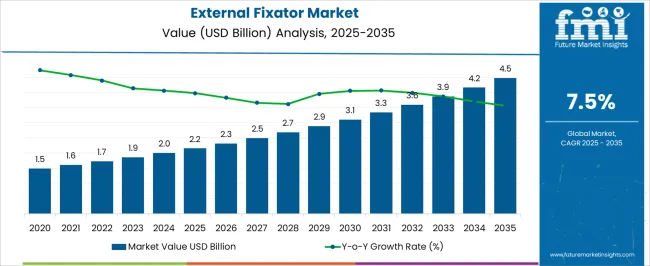
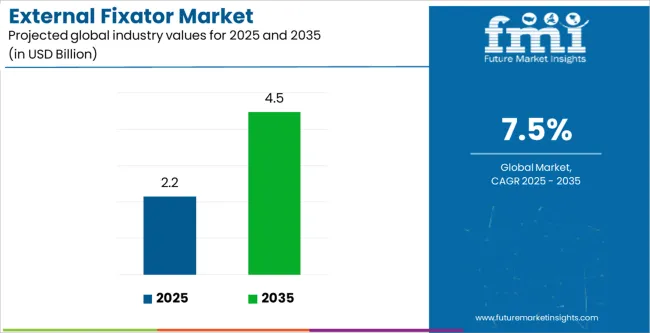
| Metric | Value |
|---|---|
| External Fixator Market Estimated Value in (2025 E) | USD 2.2 billion |
| External Fixator Market Forecast Value in (2035 F) | USD 4.5 billion |
| Forecast CAGR (2025 to 2035) | 7.5% |
The external fixator market is expanding steadily, supported by the rising incidence of trauma cases, road accidents, and sports-related injuries requiring advanced orthopedic interventions. Clinical journals and hospital data have emphasized the growing reliance on external fixators for complex fracture management, deformity correction, and limb lengthening procedures. Manufacturers have focused on improving device ergonomics, modularity, and material strength, enhancing clinical outcomes while reducing surgical complications.
Press releases from healthcare institutions have highlighted increased adoption of external fixators in trauma centers due to their ability to provide immediate stability and facilitate soft tissue healing. In addition, technological innovations, including computer-assisted frame alignment and lightweight composite materials, have strengthened treatment precision and patient comfort.
With aging populations and the rising prevalence of osteoporosis-related fractures, procedural volumes are expected to grow further. Looking ahead, market growth will be driven by the continued dominance of manual fixators, the widespread need for fracture fixation, and hospitals remaining the largest end-user segment due to their comprehensive surgical infrastructure.
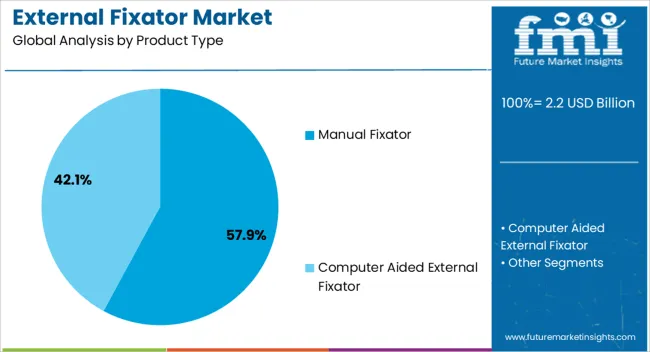
The Manual Fixator segment is projected to contribute 57.9% of the external fixator market revenue in 2025, maintaining its dominant position. This growth has been supported by the segment’s long-standing clinical utility in trauma and orthopedic procedures, where ease of application and cost-effectiveness are critical factors. Manual fixators have been preferred in emergency and resource-constrained settings due to their straightforward design and wide availability.
Orthopedic surgeons have continued to adopt manual fixators for fracture stabilization as they provide reliable fixation while allowing adjustability during the healing process. Hospital procurement data has indicated higher demand for manual devices compared to automated or robotic alternatives, largely due to affordability and surgeon familiarity.
Furthermore, training and educational programs in medical institutions continue to emphasize manual fixation techniques, reinforcing their clinical relevance. These factors have collectively sustained the dominance of the Manual Fixator segment in the overall market.
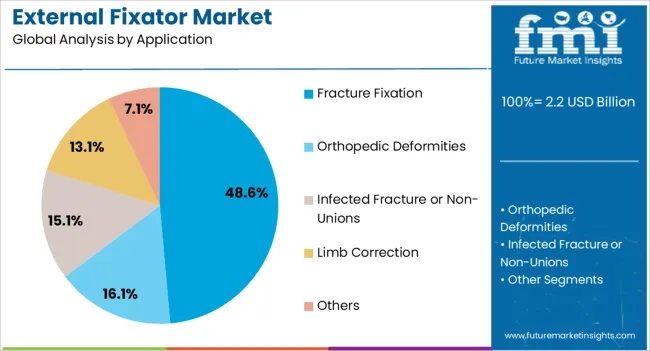
The Fracture Fixation segment is anticipated to account for 48.6% of the external fixator market revenue in 2025, securing its position as the leading application area. Growth in this segment has been driven by the increasing number of fractures caused by accidents, falls, and bone disorders such as osteoporosis. Clinical studies have highlighted that external fixators are particularly effective for complex and open fractures, where traditional casting methods are inadequate.
Fracture fixation procedures using external fixators have been valued for their ability to provide stability while preserving surrounding soft tissues, thereby reducing the risk of infection and complications. Hospital case reports have shown strong adoption of external fixators in trauma units, where immediate stabilization of fractures is essential for patient recovery.
With global trauma cases on the rise and increasing demand for advanced orthopedic solutions, the Fracture Fixation segment is expected to maintain its leadership in application use.
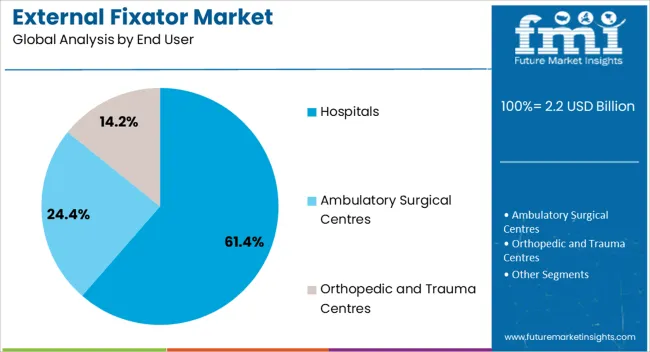
The Hospitals segment is projected to capture 61.4% of the external fixator market revenue in 2025, reflecting its role as the primary end user of these devices. Growth in this segment has been driven by hospitals’ ability to provide comprehensive surgical care, including trauma management, complex orthopedic surgeries, and post-operative rehabilitation. Hospitals have remained the largest purchasers of external fixators due to their capacity to treat high patient volumes and handle emergency cases requiring immediate fixation.
Annual reports from healthcare institutions have documented increased investments in advanced orthopedic equipment, reinforcing hospital readiness for trauma and fracture care. Additionally, hospitals employ multidisciplinary teams that ensure the safe application, monitoring, and adjustment of external fixators throughout the treatment cycle.
With specialized trauma centers expanding globally and rising surgical admissions linked to accidents and age-related fractures, hospitals are expected to retain their dominance as the leading end user segment of the external fixator market.
Demand for external fixators rose at a 6.9% CAGR between 2020 and 2025. The global market is achieving heights to grow at a moderate CAGR of 7.6% over the forecast period 2025 to 2035.
The market witnessed a significant growth during the historical period, owing to the urbanization and industrialization. Aging population and orthopedic conditions increased the demand for orthopedic treatments, including external fixation, to address fractures, and deformities.
Minimally invasive procedures, due to their advantages such as reduced tissue trauma, are leading to increased adoption. Expansion of orthopedic surgical centers facilitated greater access to orthopedic care, including external fixation procedures.
Advancements in materials science leading to the development of lighter, stronger, and more adjustable external fixators, is propelling the market prospects. Increasing demand for personalized medicine is leading to the development of customizable external fixator solutions.
New product launches and innovations in the external fixator market is one of the major factors that will augment the market growth. Focus on geriatric care will drive demand for external fixators and related orthopedic devices.
The economic growth of emerging economies creating new markets for medical devices, is all set to boost the industry growth. Integration of imaging technologies (e.g., X-ray) for improved monitoring of fracture healing during external fixation will also contribute to the market expansion.
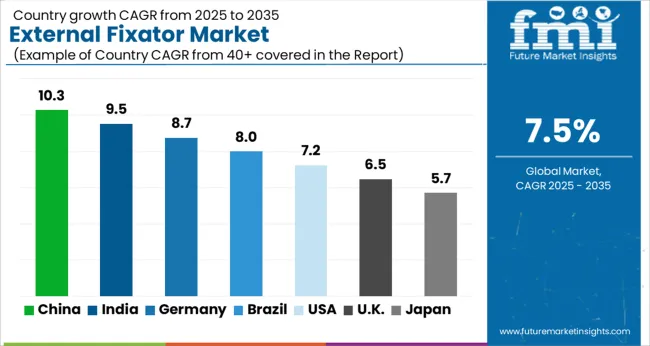
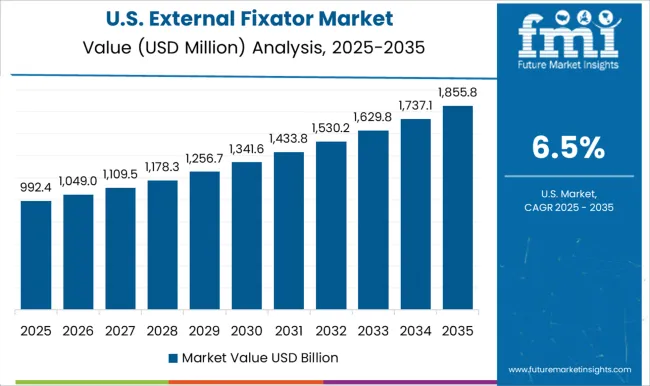
| Country | The United States |
|---|---|
| CAGR through 2035 | 6.4% |
The external fixator market in the United States will expand at a CAGR of 6.4% through 2035. The aging population in the country contributes to a higher prevalence of osteoporosis and age related fractures.
There is an increased need for external fixators for fracture management and orthopedic care, as older adults are more susceptible to fractures.
The United States experiences a high incidence of traumatic injuries due to road accidents, sports related injuries, and workplace incidents. The trend drives the demand for external fixators as a primary treatment option for stabilizing fractures and facilitating bone healing.
| Country | The United Kingdom |
|---|---|
| CAGR through 2035 | 7.7% |
The external fixator market in the United Kingdom to expand at a CAGR of 7.7% through 2035. The National Health Service in the country provides comprehensive healthcare coverage to residents, including orthopedic services. The availability of orthopedic treatments, including external fixator procedures, through the NHS supports market growth by ensuring access to care for patients.
Continuous advancements in orthopedic surgery techniques and technologies contribute to the growth of the external fixator market in the United Kingdom. Innovations in external fixator design, materials, and surgical techniques enhance treatment outcomes and patient satisfaction, driving market expansion.
| Country | China |
|---|---|
| CAGR through 2035 | 13.2% |
External fixator trends in China are taking a turn for the better. A 13.2% CAGR is forecast for the country from 2025 to 2035. China has made significant advancements in medical device technology and innovation.
Continuous improvements in external fixator design, materials, and surgical techniques enhance treatment outcomes, driving the adoption of advanced fixator systems.
Rising healthcare spending in China, driven by economic growth and increasing health awareness among the population, supports investments in medical devices and technologies, including external fixators. Expanded healthcare coverage and reimbursement policies further stimulate market growth.
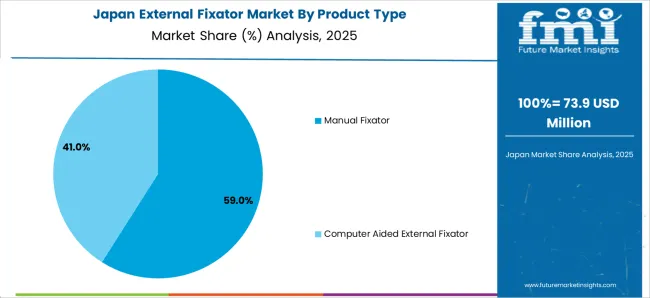
The external fixator market in Japan is poised to expand at a CAGR of 9.8% through 2035. There is a growing preference for minimally invasive surgical techniques in Japan, driven by the desire to reduce patient morbidity, shorten hospital stays, and accelerate recovery.
External fixators offer minimally invasive solutions for fracture stabilization, aligning with this trend and driving market growth. Japan has a high standard of healthcare with advanced medical infrastructure and skilled healthcare professionals. The availability of advanced orthopedic treatments, including external fixation procedures, supports market growth by ensuring access to quality care for patients.
| Country | India |
|---|---|
| CAGR through 2035 | 7.6% |
The external fixator market in India will expand at a CAGR of 7.6% through 2035. Sports related injuries are on the rise, and external fixators play a crucial role in the management of sports injuries.
India has one of the highest rates of road traffic accidents globally. Road accidents often result in traumatic injuries, including fractures, which require external fixators for stabilization and management. The high burden of road traffic accidents drives the demand for external fixators in India.
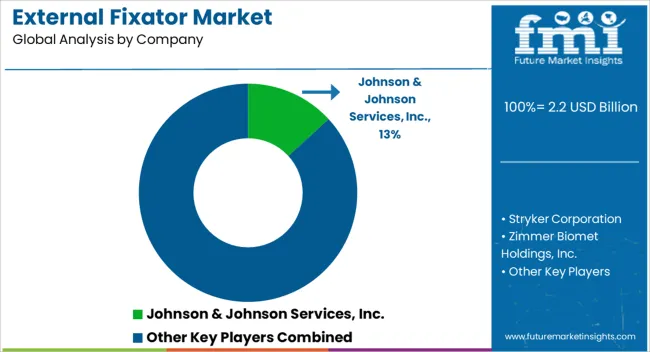
The external fixator landscape is characterized by the presence of several established players, as well as emerging companies striving to gain market share through innovation, strategic partnerships, and geographical expansion.
Key Developments
| Attribute | Details |
|---|---|
| Estimated Market Size in 2025 | USD 2.0 billion |
| Projected Market Valuation in 2035 | USD 4.2 billion |
| Value-based CAGR 2025 to 2035 | 7.6% |
| Forecast Period | 2025 to 2035 |
| Historical Data Available for | 2020 to 2025 |
| Market Analysis | Value in USD Billion |
| Key Regions Covered |
North America; Latin America; Western Europe; Eastern Europe; South Asia and Pacific; East Asia; The Middle East & Africa |
| Key Market Segments Covered |
Product Type, Application, End User, Region |
| Key Countries Profiled |
The United States, Canada, Brazil, Mexico, Germany, France, Spain, Italy, Russia, Poland, Czech Republic, Romania, India, Bangladesh, Australia, New Zealand, China, Japan, South Korea, GCC countries, South Africa, Israel |
| Key Companies Profiled |
Johnson & Johnson Services Inc. (DePuy Synthes); Stryker Corporation; Zimmer Biomet Holdings Inc.; Smith & Nephew plc; Orthofix International N.V.; Ortho-SUV Ltd.; Response Ortho LLC |
External Fixators are categorized as manual fixators and computer aided external fixators.
External fixators are used for addressing orthopedic deformities, fracture fixation, infected facture or non unions, limb correction and other applications.
Hospitals, ambulatory surgical centers, and orthopedic and trauma centers make high use of external fixators.
External fixator market analysis has been conducted in major countries in North America, Latin America, Western Europe, Eastern Europe, South Asia and Pacific, East Asia and the Middle East and Africa.
The global external fixator market is estimated to be valued at USD 2.2 billion in 2025.
The market size for the external fixator market is projected to reach USD 4.5 billion by 2035.
The external fixator market is expected to grow at a 7.5% CAGR between 2025 and 2035.
The key product types in external fixator market are manual fixator and computer aided external fixator.
In terms of application, fracture fixation segment to command 48.6% share in the external fixator market in 2025.






Full Research Suite comprises of:
Market outlook & trends analysis
Interviews & case studies
Strategic recommendations
Vendor profiles & capabilities analysis
5-year forecasts
8 regions and 60+ country-level data splits
Market segment data splits
12 months of continuous data updates
DELIVERED AS:
PDF EXCEL ONLINE
External Storage Market Size and Share Forecast Outlook 2025 to 2035
External Anti-infective Preparations Market Size and Share Forecast Outlook 2025 to 2035
External Blinds Market Size and Share Forecast Outlook 2025 to 2035
External Pacemakers Market Size and Share Forecast Outlook 2025 to 2035
External Defibrillators Market Size and Share Forecast Outlook 2025 to 2035
External Gear Pump Market Size, Growth, and Forecast 2025 to 2035
External Combustion Engine Market Growth & Demand 2025 to 2035
Animal External Fixation Market Size and Share Forecast Outlook 2025 to 2035
Automated External Defibrillator Market Analysis – Size, Share, and Forecast 2025 to 2035
Wrist Fixator Procedure Kit Market
Radiolucent Wrist Fixator Market
Computer Aided Trauma Fixators Market

Thank you!
You will receive an email from our Business Development Manager. Please be sure to check your SPAM/JUNK folder too.
Chat With
MaRIA